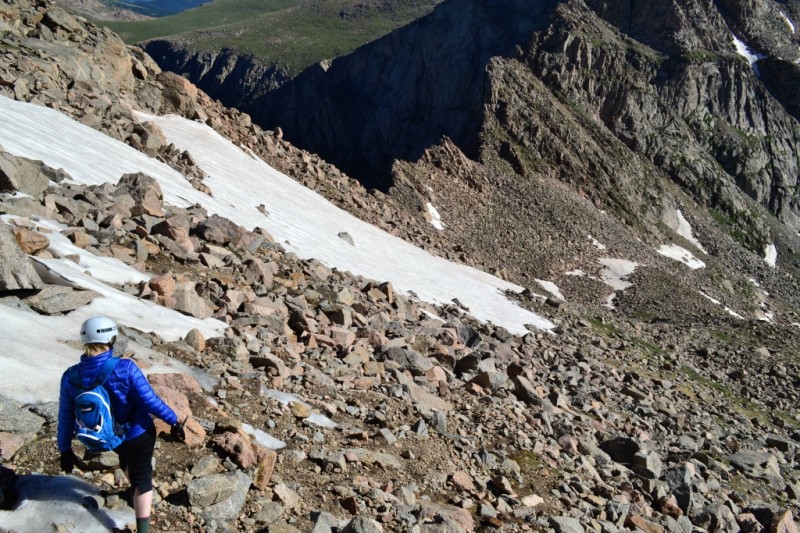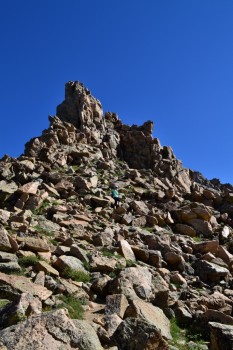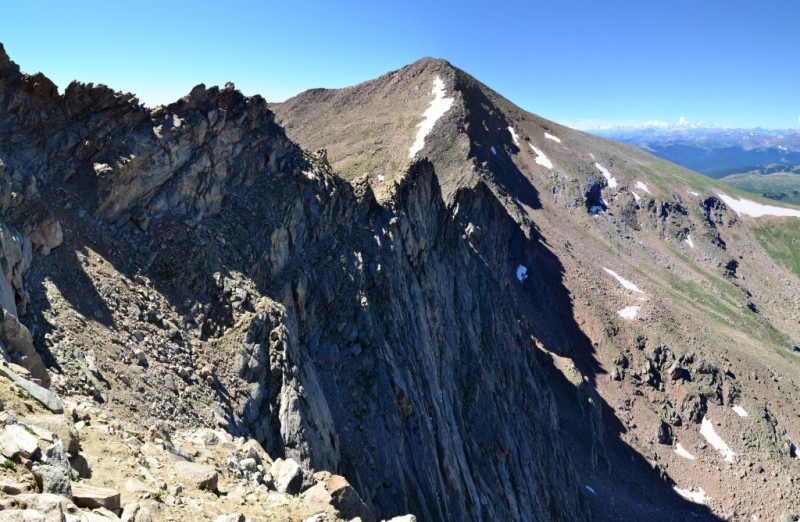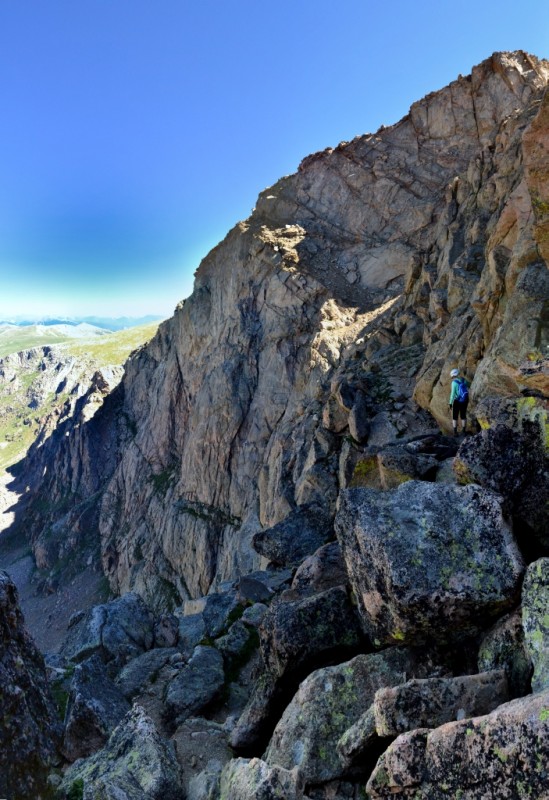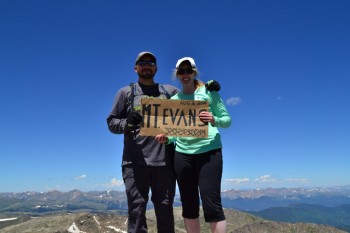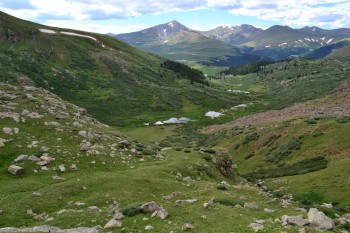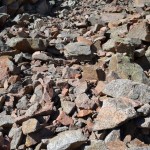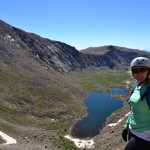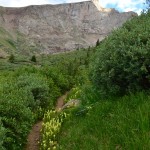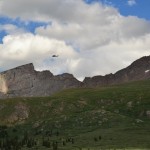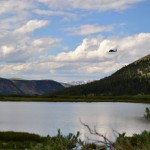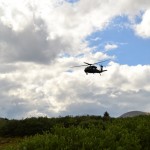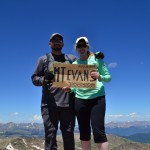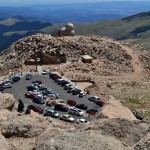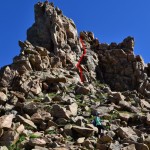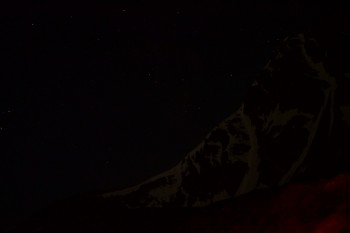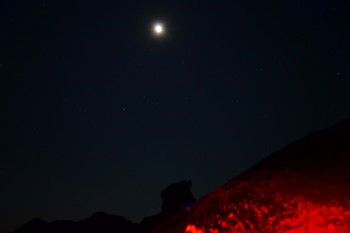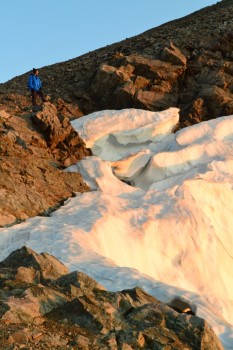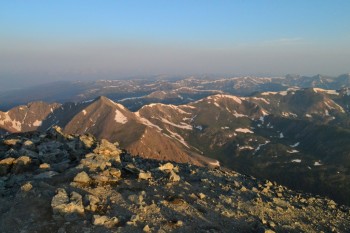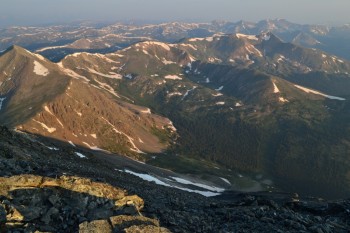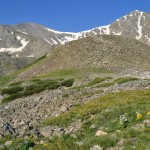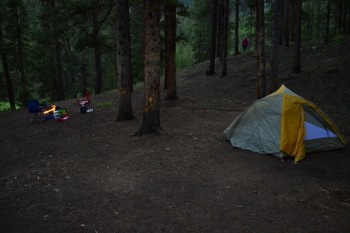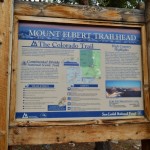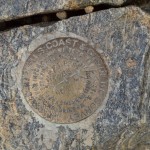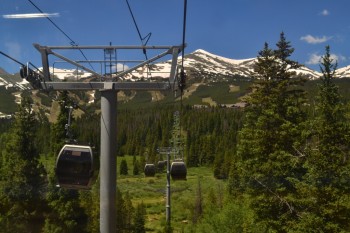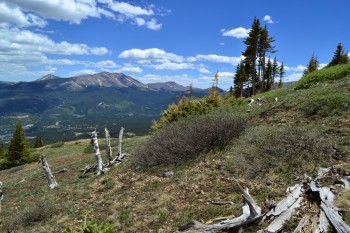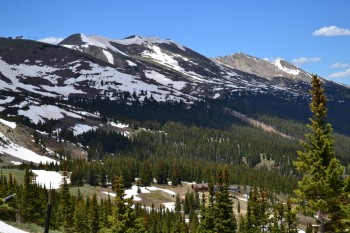Take a Walk
A Quest into the Wild
The Sawtooth (Mt. Bierstadt & Mt. Evans)

Distance: 11.2 miles (out and back) Elevation Gain: 4,335 ft (total gain)
Max Elevation: 14,265 ft Min. Elevation: 11,473 ft
We did Mount Bierstadt last year, that route is shown in green in the above Google Earth maps. The blue shows the new route we took to do the Bierstadt-Sawtooth-Evans combo. On the right is a closer look at the Bierstadt-Sawtooth-Evans combo.
After repeated checks of the weather on Mountain Forecast up until 4:00 am on Saturday morning, we determined it was the perfect day to attempt the infamous Sawtooth route that connects 14ers Mt. Bierstadt and Mt. Evans. Nice weather is critical for a successful trip across the Sawtooth and neither of us were willing to take a chance being stranding on jagged rocks above 13,000 feet in a thunderstorm. With a green light on weather, we left the house in the dark shortly after 4:00 am and began the drive to Georgetown and up Guanella Pass. We approached the trailhead for Mt. Bierstadt about 15 min. to 6:00 am and already several cars and groups were prepping to go up Mt. Bierstadt which is one of the easier 14ers on the Front Range. We enjoyed a climb up this mountain last September. This time we had a much longer, intense day planned.
The Sawtooth is a great traverse that connects Mt. Bierstadt to Mt. Evans (after quite a bit more hiking). It gets its name from several aretes (jagged knife-like rock formations) that line up to look like the teeth of a saw. The traverse is a class 3 route with some class 2+ scattered throughout. The route can be crossed either direction, but most people, including us, opted to start at the summit of Mt. Bierstadt so we had fresh legs for the traverse. Our early morning climb up Bierstadt was a warm-up hike for what lay ahead for the rest of the day. Frost blanketed the ground and a chill hung in the air as we began. We paused for a few photos, but managed to summit in two uneventful hours. Seen below are early morning photos of the Sawtooth as we made our way toward her.
When we reached the summit we paused for 15 min. or so to rest, take photos, and snack. There were several people on the summit already. We found a quiet spot towards the north side of the peak that looked down towards the traverse to mentally prep. Seen below are photos from the summit before we started the Sawtooth. Notice the Sawtooth in the background.
We donned our helmets and proceeded with our next task of down climbing the steep incline towards the saddle. There was much screw and loose dirt until we reached the boulders. Many sections here required us to lower ourselves waist level down to reach the next rock. While the scree was annoying, bouldering was a rather fun challenge. Unfortunately, due to a very large snow drift located higher on the traverse, we were forced to downclimb a little lower than we wanted to on the route. Not a huge deal, but it meant having to climb back up a bit more later. Seen below are photos of the initial descent of the traverse looking downward as well as back up to the summit of Mt. Bierstadt.
Once we reached the saddle, we faced our next obstacle. Midway between the traverse, climbers are greeted with a large gendarme (spike rock/isolated spire found on a ridge). It is the most challenging portion of the climb requiring solid class three (a fall would hurt very badly) moves to get up and over the top. Nonetheless, if you are not in the mood for the challenge there is an alternative route that goes along the right side of the pinnacle that is just class 2. We wanted a nice challenge, so opted for the direct up and over climb. The moves required good balance and arm strength, but this climbing portion was short. Seen below are photos of the gendarme and climb up. Yeah…it was a bit steep…The last photo displays the remaining route on the east side of the traverse.
We were excited to have gotten safely through this crux and were ready for the next challenge, the ledges. This was more of a mental challenge than a physical one due to the staggering exposure. After the gendarme, we followed the traverse to a notch that leads to the west side of the sawtooth. Yep, the side of the traverse that you can see as you hike up Bierstadt. The side that greets hikers and climbers with sheer cliffs that drop a thousand below to the valley. Luckily, there is a mostly decent path that follows along the traverse and steadily upwards. Most of the path was at least 4 feet wide. Seen below are photos of the west side of the traverse and a video clip.
After traversing this narrow passage way, we began to climb back up via a narrow talus ramp. This was probably the most challenging portion because the beginning of the path was steep and full of loose rock and dirt. We were very anxious to get up and over at this point. Fortunately, as you ascend higher, the path gives way to another option closer to the wall that contains a bit more solid rock to grip on to. Overall, there isn’t any real danger to falling here if you are wearing proper footwear and taking it slow and steady. Getting over the mental hurdle is by far the most challenging, and probably the biggest risk to one’s safety. After this, we were home free on a wide open field. There is no trail here, but we easily wandered toward West Evans and weaved our way through the boulders interspersed throughout the mountaintop meadow. Seen below is a photo looking back on Mt. Bierstadt and the Sawtooth. We came from just above the snow drift. We felt a sense of accomplishment as we gazed back on our completed path.
We soon thereafter reconnected with a trail to West Evans and ran into several other hiking groups. Naively, we figured Mt. Evans (east, true summit) was just around the corner. Little did we know we had a long class 2 traverse over to the summit and observatory. Once the route reaches a notch after coming up from the end of the Sawtooth the trail drops down and moves alongside the West Ridge of Evans. We both decided to take what looked like a class 3 route that we thought would circumvent and then reconvene with the main trail without losing any elevation. So, we both took the high road and got some more practice scrambling. This route hits two more 14,000 ft. “peaks” before hitting the main Evan’s summit. Below is a look back from the summit of Evans at the West Ridge, the peak marked 14,252 ft is sometimes called “West Evans.”
For those that are not familiar, Mt. Evans is accessible by car. In fact, it boasts the highest paved road in America. The summit has bathrooms, a storm shelter, observatory, large parking lot, and what looked to be a gift shop. It was quite overwhelming to be honest, when we reached Mt. Evans. Tourists were everywhere. The summit was quite crowded. It was weird to have worked so hard to get there, and then be surrounded by tons of people who walked 200 feet from their cars. However, it was the first time we had ever gotten to have our picture taken together on a summit. Some really nice people offered to take our photo and even lent us their summit sign. Seen below are photos from Mt. Evans.
We then began the long slog back across the traverse to the original meadow right past the sawtooth exit. We had previously placed waypoints into our GPS that led us right to the gully. We thought we were home free at this point, but soon realized getting down the gully was no easy task. There was a trail, but it was very steep and loose (average 43% grade). We picked our way slowly and carefully down the chute through the dirt and scree. It honestly seemed to take forever. The path loses 1,726 ft. in 1 mile according to our GPS. Trekking poles would have come in handy at the gully.
We finally reached the valley, and proceeded onto nice trail for a brief reprieve. We crossed a beautiful meadow. Flowers were in full bloom everywhere, and a gorgeous waterfall splashed the valley wall behind us. Things were right again in our hiking world. Seen below are photos of the gully and valley.
We paused for a pop-tart, since the visible parking lot looked extremely far away. The path led us now into the dreaded willows. There was a trail, but barely and it led straight through small ponds and smelly mud at times. The willows were often taller then we were. At times, we couldn’t see where we were or where we were headed. It made for an interesting adventure. If only the mud had not been there.
At some point in the willows, we looked upward in response to a loud noise. A blackhawk helicopter was flying right above us. (We felt like we were in Vietnam or some war zone for a moment.) The chopper flew towards the summit of Mt. Bierstadt, and we now knew someone was in trouble and needed mountain rescue. We found out later in the news that a women was having respiratory issues near the summit of Bierstadt. Seen below are photos of the willows and the chopper (check out the gallery for more pictures of the chopper).
The willows lead back to the standard Bierstadt trail just east of Scott Gomer Creek, the creek you have to cross to get to Bierstadt. Thus, we made the creek crossing one more time and were about three-quarters of a mile from the parking lot. It had turned into a very pretty day and we were very happy to be back at the car. We looked back at Bierstadt, the Sawtooth, and the Gully and smiled at our accomplishment.
Major points and advice from this trip:
1. Start very early. The trip took us longer than we anticipated due to the long class two traverse to get to Mt. Evans and the slow going down the steep gully and mud filled willows.
2. Gaiters would be helpful in the willows, but aren’t necessary. The mud came up past our ankles at certain points and there are a few water crossings that you have to jump.
3. Trekking poles are very helpful on this hike in the gully and on the traverse to Mt. Evans. However, you need to have a way to secure them to your pack so your hands are free to climb if you plan on doing the Gendarme or on other class 3 segments. (They are also useful for icy segments.)
4. Go slow and take your time. It isn’t worth it to break something or fall. Many sections are slippery and steep, watch your footing.
5. Have fun!
Grays and Torreys Combo (Standard Route)

Distance: 8.52 miles (out and back) Elevation Gain: 3,640 ft (total gain)
Max Elevation: 14,278 ft Min. Elevation: 11,225 ft
A couple of factors made us get into the X-terra at midnight, drive out to the Grays-Torreys trail-head, and start hiking to the summits at 2 in the morning. For one thing, Grays and Torreys are argued to be the most popular climbs in Colorado. They are easy to access from the major metro areas of Colorado (Denver, Boulder, and Colorado Springs) and are just off I-70. They are also relatively easy climbs and afford amazing views. Because of this there can be throngs of people in a veritable conga line all the way up. So there was that.
We also wanted to watch the sunrise at least once from a 14er. So why not from the top of Grays? The added bonus of missing the crowds just made it that much sweeter. And so there we were at 2 am with headlamps and bleary eyes staring off into the darkness. We started officially at 2:15 am.
Even though it’s summer here it can still be chilly in the mountains, and since the trail-head starts at around 11,225 ft. we were wearing a few layers, and our breath was clearly visible in the light of our lamps. Beginning the hike we just set our lamps to low red light and admired the stars, beauty, and stillness of the night. We made quick work of the willows and even quicker work of the open area in the basin before the real climbing began. Below are some pictures from our night hiking.
Around mile 2.5 the most challenging part of the hike begins. The trail gains roughly 1,180 ft. in 1 mile. It’s not the Manitou Incline or anything, but it is steep, and the rock can be loose. After this section (2.5 – 3.5 miles into the hike) you are at about 14,000 ft. and are nearly there. The summit of Grays sneaks up on you quickly and you think, “Wow, I’m here already?”
When we arrived on Grays’ summit it was roughly 5:10 am. There was a faint glow of light to the east as the sun hinted that it was ready to rise. We cuddled on the peak for warmth and to hide from the wind as we waited for Sol to make his appearance. Sadly, it was a little chilly and we decided we’d seen enough of the sunrise for now — we needed to move. We began the 600 foot down climb into the saddle and towards Torreys. Below are a few images from the predawn Grays summit.
As we headed down the saddle between Grays and Torreys we excitedly remembered throwing some hand warmers in the packs. The wind wasn’t horrible, but it was enough when combined with the temps in the mid-30s, to chill our fingers even with light gloves. Towards the trough of the saddle we looked to our right and saw the sun for the first time. It looked like a ball of fire glowing in the dawn. Here are a couple images of that scene.
As we crossed the saddle the light was amazing. The pink glow from the sunrise reflected off the snow, the rock, and even the plants to make all of nature appear at once similar and different than we’d ever seen it before. We stopped frequently on our way up Torreys to admire the beauty all around us. Below are a few pictures from that hike up Torreys.
As we continued to head up Torreys we were just having too much fun not to take a few more pictures of the splendid scenery around us. Here are a few more pictures from about midway up Torreys.
And there we stood on the summit of Torreys. We had officially completed our first double summit. It was very different from the Grays summit as it was much smaller. When on Grays gazing north, Torreys blocks some of the view of the Front Range, but on Torreys there is nothing north to block the view. It was quite amazing, and we were alone and had the summit to ourselves. Well, almost to ourselves. As we ate our peanut butter and jelly sandwiches a small ground squirrel kept running out at us and squeaking. We interpreted this squeaking as, “Give me food.” We replied that we were sorry, but it is illegal to feed wild animals. He or she was very disappointed.
We walked around the summit of Torreys for a while and even went over to look at Kelso Ridge, a class 3 climb to the summit of Torreys which is on our list of goals for the summer. And we also shot a video on the summit. Below are some images and the video from Torreys.
Below are images of Kelso Ridge. The White Wall and Knife Edge are easily visible.
After hanging out on Torreys for about 30 minutes we decided to start climbing back down towards the car. The route to get back down cuts from the middle of the saddle back across the northeast face of Grays and meets back up with the main trail. There is a patch of snow and ice on the traverse, but it is very doable in hiking boots or even good grippy trail running shoes. Below is a picture of the traverse and an image (taken from Torreys) showing the main trail up to Grays (green), the traverse across from the saddle (red), and the route across the saddle (blue).
Once across and back on the main trail we noticed that there were quite a few climbers coming up. In fact, we played a game on who could guess the number of climbers we’d pass on the way down. Allyson won with a guess of 800. We counted 710 climbers on the way down, and we started counting pretty late! That must have been a busy summit later in the day. It was crazy to think we were the only ones up there and by the time we came down there were over 700 people vying for space up there.
As we continued to go down we noticed something that was impossible to see in the dark of night, flowers! They were everywhere. The heavy rains we have been getting has made this a great year for wild flowers and the basin of Grays and Torreys is no exception. Pretty much every type of flower we have ever seen in Colorado and beyond was represented. It was quite lovely. Below are a few images of flowers for your viewing pleasure.
And after dodging 710+ people climbing up, as we tried to climb down, we were finally back at the parking lot. It was a beautiful day and still morning! We planned on heading back towards Denver and stopping to get breakfast. All in all a great start to the day. And even if we were pretty tired, it was well worth it!
Just a couple notes on this hike.
First, actually getting to the Grays trail-head isn’t as easy as some people make it sound. We climbed Grays last year and the dirt road up to the trail-head was rough at one point, but this year after all the rain it is pretty gnarly. The X-terra was definitely using that 4-wheel drive and the clearance was just barely enough to get over some of those ruts. Coming down later we saw a Subaru stuck and trying to reverse out of this rough area. If you plan to drive up make sure you have a good vehicle with 4-wheel drive and decent clearance.
Second, many people seem nervous about where the trail splits, one path going to Torreys the other to Grays. This occurs once you are well into the hike and there is a post in the ground saying “Stay on the Trail.” But if you look at the post a little closer there is a note written in permanent marker that says “Grays” with an arrow pointing to the left. This is where you want to turn left unless you want to go to Torreys first.
Mt. Elbert Summit: 14,433 ft

Distance: 9.62 miles (out and back) Elevation Gain: 4,408 ft (total) 4,377 ft (net)
Max Elevation: 14,433 ft Min. Elevation: 10,056 ft
All week long we constantly monitored Mountain Forecast for conditions atop Colorado’s highest peak, Mount Elbert, hoping for an opportunity to summit this spectacular mountain. Nestled about 115 miles southwest of Denver in the Sawatch Range, this gentle giant rests majestically in the San Isabel National Forest. In addition to laying claim to Colorado’s highest point, Elbert also ranks 2nd in the race to the sky in the contiguous US falling only slightly behind California’s Mt. Whitney which sits at 14,505, a mere 72 higher. Interestingly, Elbert hasn’t even been able to peacefully claim its record here in Colorado through the years. Just north of the peak sits Mt. Massive. Massive is essentially a row of peaks, all leading up to a pinnacle of one high point on the central peak which measures 14,428 ft. Through the years, there have been collective groups arguing for Massive to be named the highest peak in Colorado. Hikers/wilderness enthusiasts that got a a little too excited about this race took to building cairns on the summits of either peak hoping to gain a few feet of mountain height and with it a title. This battle resulted in Team Elbert or Team Massive simply tearing down each other’s work. Eventually, these futile efforts ceased leaving Elbert rightfully dubbed the highest Coloradoan Peak.
We used vacations days for a summit attempt on Friday, in order to avoid large hiking parties that often descend upon the 14ers on a July Sat. or Sunday morning. Since the trailhead is relatively far from our house, we opted for a Thursday night campout near the TH. Luckily, Mt. Elbert and Mt. Massive rise above perfect campgrounds. There are multiple fabulous spots located at Halfmoon east and west campgrounds as well as the Elbert Creek Campground just across the dirt road from the Elbert Northeast Ridge Trailhead. We were really hoping to get one of these campsites, but to our surprise they were already full at 6:00 pm on Thursday. We kept going north until the road turns into a 4WD only road and followed it past the pay campsites. We stumbled upon an amazing primitive site that overlooks the Elbert creek. It was perfect. We set up camp and roasted marshmallows. The peaceful sound of the river calmed us after a long trek into the mountains. Seen below are photos of our campsite.
At dusk it began to rain. We crawled into the tent for an early slumber that didn’t come easily. The night was a bit of a rough one, with our cheap sleeping bag pads not cutting it. We finally fell asleep and when first light came through, we weren’t quite ready to rise. But the mountain we were planning on climbing is tall and steep and long to the summit so we threw on our boots and made the short drive to the trailhead. After eating a a snack and prepping, we were on the trail at 7:15 am. The Northeast trailhead quickly connects hikers to the Colorado Trail. We followed the Colorado Trail through a dense lodgepole pine forest for 1.1 miles where it intersected with the trail that leads to the Elbert Summit. The signage is very clear here, and we had no trouble route finding. Since, we began this hike around 10,000 feet, our trek below treeline seemed to take forever. There were also very steep sections through the trees that allowed us to shed layers pretty early on in the trek. As we reached treeline, the canopy opened up to beautiful views of the valley below as well as our first view of one of Elbert’s two false summits. Seen below are photos from the trees, and treeline, and the first of the false summits.
Mosquitoes began to attack ferociously right before we left treeline. We had to keep moving or we would be swarmed. This was quite surprising to us considering we were over 12,000 feet in elevation at this point. We were about 2.3 miles into the hike now and realized we still had over 2,000 feet to climb in about 2.2 miles. The first false summit loomed in front of us, teasing us with hope. We steadily climbed until just below this first summit. The trail turned very very steep here and was comprised of loose scree and dirt. Trekking poles came in handy for balance for this portion of the ascent. It was mentally a very challenging portion of the hike because we had reached 13,000 feet, air was thin, and the trail was visually daunting. Once we got past this point, we saw our next false summit, but thanks to our handy GPS we knew we had only about 800 feet left to climb. We were almost there! Seen below is the final 200 foot pitch and ridge line to the real summit.
A few more feet up, and we were there. We had reached our goal in about 3 hr 45 min. which wasn’t too bad considering we paused for some photos and sunscreen along the way. The conditions were perfect on top with minimal wind and adequate sunshine to keep the temperatures reasonable. We sat and enjoyed PB&J bagels and water to refuel. Seen below are 360 views from 14,433 feet.
Seen below is a video on top of the summit and ridge right before we headed down.
The weather report said pm rain showers were very likely, so we headed down after lunch. We were surprised to see so many people heading up the mountain as rain clouds filled the sky behind us. The trek down was hard in a different way than going up. It may have been easier cardiovascularly speaking, but was much more difficult on the quads. The thought of the storm cloud getting closer kept us moving very very quickly despite the build up of lactic acid in our legs. The saying “going up is optional, going down is mandatory” echoed in our heads.
As we neared treeline it began to storm and we realized that the raindrops were in fact hail drops. We knew that light showers were a possibility in the pm, but we didn’t expect hail and lightning. The thunder was ferocious and instilled quite a bit of fear in our hearts. We wanted to jog down, and did at some points, but the steepness and loose nature of the climb down prevented us from descending too quickly. Even as we saw ground-to-air lightning strikes and heard mean sounding thunder we still continued to see hikers climbing up out of treeline. We want to take this time to warn hikers that the danger of lightning is real. On Friday, the day of our hike, in probably the same storm, a woman was killed and seven were injured by a lightning strike on the Ute Crossing Trail in Rocky Mountain National Park. We were deeply saddened to learn about this and then shocked to learn of a second fatality on Saturday when four individuals were struck on Trail Ridge Road in Rocky Mountain National Park.
We know how tempting it is to keep climbing. And we know how much effort goes into planning trips to the mountains, especially when you are from out of town. But trust us, the summit is not worth your life, and you can’t outrun a storm. Please stay safe and if you see storm clouds in the mountain get down as quickly as you safely can. Our condolences and thoughts are with the families of those who lost their lives this weekend. Below is a picture of the storm as it passed by us.
After reaching treeline it was a long hike back through the forest to the car. The scenery is relatively monothematic in the trees and we were happy when we arrived back at the car. When we reached the car the second wave of the storm hit and it began to rain very hard. We threw our gear in the back and headed over to Leadville for some grub.
If you make it up to Leadville and the Sawatch Range make sure to stop by the Silver Dollar Saloon. Opening in 1883 this famous bar served the likes of Doc Holliday (who had his last gunfight in front of the bar), Wyatt Earp, Oscar Wilde, and many others who passed through the doors of this majestic bar. The town is extremely friendly and they have many outdoor events such as the Leadville 50 and 100 mile mountain bike races.
It had been a hard day, and even scary at times, and we were thankful for another day in the mountains.
Breckenridge Peak 8 Fox Sighting and More

Distance: 2.8 miles (loop;out and back) Elevation Gain: 1,587 ft. (total) 1,467 ft. (net)
Max Elevation: 12,615 ft. Min. Elevation: 11,148 ft.
We decided to explore Breckenridge a little bit more after our Quandary expedition and headed over towards the base of Peak 8. On the way we found that the gondola was free (at least in the summer) and parked (again at a free lot). The gondola was nice, but the plexi-glass windows were really scratched up, presumably from skis and poles, which made it slightly difficult to see outside; but it was still very fun to ride up in the gondola on what was a gorgeous day. Below are two pictures from our gondola experience.
The gondola drops you off just off the base of Peak 8, so we walked past a little lodge and on to the lifts. We found out that you could rent mountain bikes at the base and then get a full-day lift ticket to go up the mountain and then back down on your bike. It sounds and looked like a lot of fun, and we plan to go back with our own mountain bikes to ride. We opted to buy a one-time scenic lift pass to ride the Independence Superchair up to the bottom of the Whale’s Tail (the structure that connects Peak 7 and 8 and forms a beautiful bowl).
The ride cost $10 each and was well worth it. Neither of us had ridden a ski lift in the summer and it was a very different experience. For one thing, you are much higher up, since there is roughly 6-8 ft. of base snow missing below you! It was a perfectly clear day and looking around we could see Gray’s and Torrey’s Peaks off in the distance behind us, Peaks 9 and 10 to our left, and Peaks 7 and 8 in front of us. Above are some of the images from the ride.
As we neared the top of the lift we prepared to unload for the first time wearing shoes. It was easy as pie. Now at the top we had to decide what to do. Our first decision was to head over to what appeared to be a rugged scenic overlook just off to the left of the lift. Once there we looked out at where we had come from and then on to the mountains beyond. It was quite a sight. There are a couple photos below from our photo op.
We took a look around and decided that we’d head up towards Peak 8, following the T-Bar lift. It was very steep and we almost turned back at first, since this was supposed to just be a relaxing day. But we kept telling ourselves that we’d just go up to the next ridge to see the view, and then the next ridge, and then the next ridge. Eventually we had a mission to go until T-Bar ended. The last portion of the T-Bar route was very steep indeed. Using our GPS and Mapsource we calculate that the last couple hundred feet of the climb is at a 42.4 degree angle (or a 45% grade). Whew! Below are some pictures from the climb up.
At the top of the lift we took a seat on the steps of the T-Bar operations cabin, and suddenly Allyson spotted an animal up the ridge. We took out the telephoto lens for the camera and tried to spy what it was. Zooming in on one of our pictures we could tell immediately it was a red fox. We decided to try and get just a little bit closer, and as quietly as we could we walked up and away from the fox. Very abruptly after coming over a little ridge the fox was in plain sight, sitting down and just hanging out. We snapped as many pictures as we could and then the fox decided it was time to move on. Below are the best pictures we took of our fox sighting at 12,200 ft.
We attempted to follow our fox friend, but he was long gone. However, we did see the false summit for Peak 8 and decided we’d keep going until we reached it. On our way up we began to encounter the first large patches of snow, and since we hadn’t planned a real hiking day our sneakers didn’t enjoy that very much thus definitively ending our trek. Once at the false summit we looked around at the Dillon Reservoir, the Ten Mile Range, the Front Range, and Breckenridge below us. It was quite a sight. Up above us loomed Peak 8 and just off in the distance Peak 7. Below is a small panorama and a few pictures from the false summit at 12,615 ft.
We began our descent and realized for the first time just how steep the climb really had been. The terrain was loose rock and gravel for much of the climb down and some mud towards the top, it was definitely slippery going in sneakers. We decided to try another route at a crossroads and instead of following T-Bar down the rest of the way climbed down Pika and Ptarmigan. We thought this alternate route might be less steep and offered us more opportunities to explore. This route had quite a bit more terrain to navigate including bushes, streams, mud, etc., but allowed more ease in the descent since we were no longer on a double black diamond. We were very excited to reach the bottom of the run and head back over to the chair lift for our ride down! Below are a couple pictures from the descent.
Back at the chair lift we got in the non-existent line and hopped aboard. It was really exciting riding the chair lift down and was probably the first time we’d ever ridden a chair lift down the mountain. Back at the base we headed to the restaurant Seven for some burgers and refreshments. It was a day very well spent and we were very excited about our unexpected wildlife success. We’ll be back soon with mountain bikes and with our hiking boots to finish what we started! Until next time, stay classy Take a Walk readers and vote for this picture so we can continue to share with you our Colorado photography and enhance your viewing experience.








